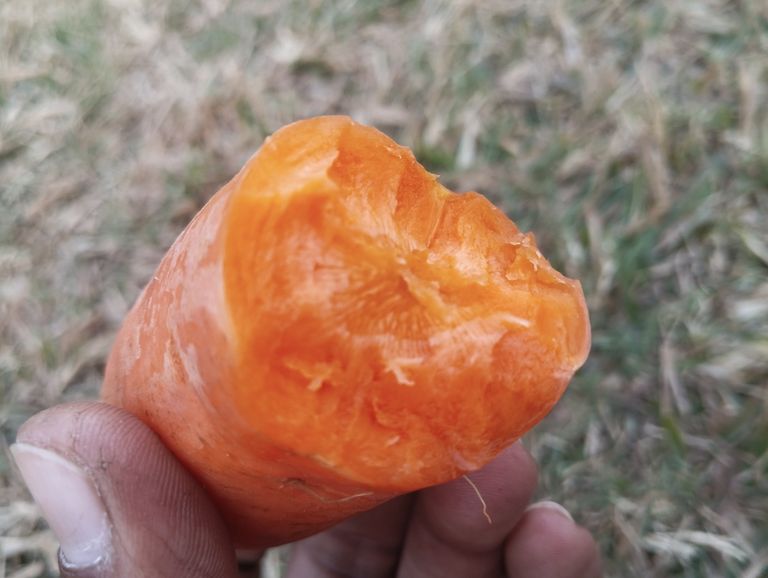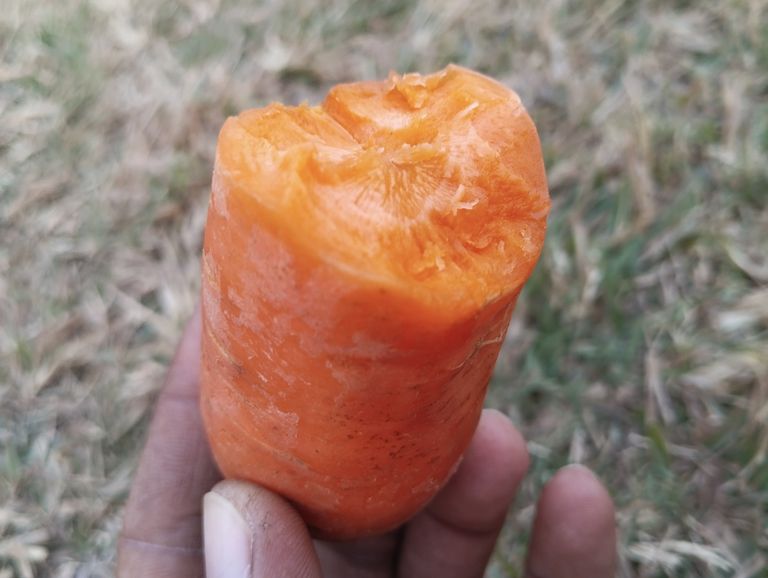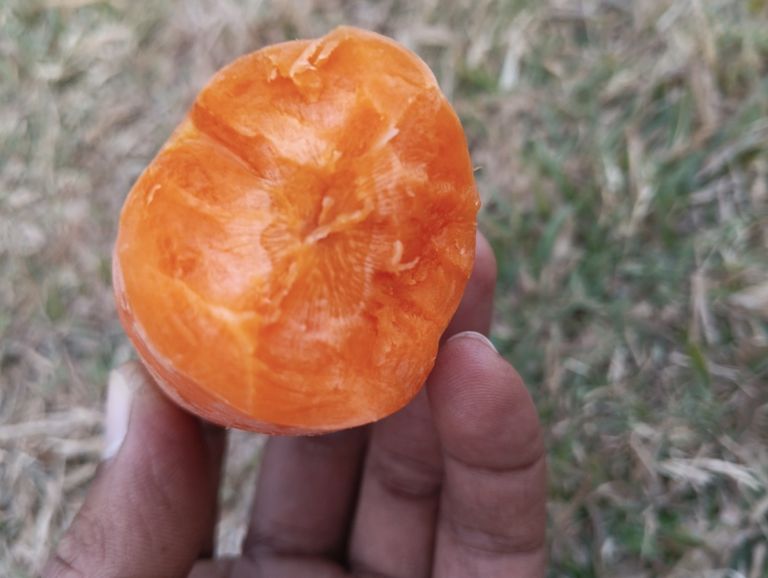
Health Benefits of Eating Carrots.
Carrots are one of the most popular and nutritious root vegetables, known for their sweet taste, vibrant orange color, and crunchy texture. They are packed with essential vitamins, minerals, and antioxidants that contribute to overall health. Whether eaten raw, cooked, or juiced, carrots offer numerous health benefits. In this article, we will explore the various advantages of including carrots in your diet.
- Rich in Nutrients and Antioxidants
Carrots are an excellent source of essential nutrients, including:
Vitamin A – Promotes eye health and strengthens the immune system.
Vitamin K1 – Supports blood clotting and bone health.
Vitamin C – Boosts immunity and skin health.
Potassium – Helps regulate blood pressure.
Fiber – Improves digestion and promotes gut health.
Beta-carotene – A powerful antioxidant that converts into vitamin A in the body.
The presence of these nutrients makes carrots a superfood that enhances overall well-being.
- Promotes Eye Health
Carrots are famously linked to improved eyesight due to their high beta-carotene content. Beta-carotene is converted into vitamin A, which plays a crucial role in maintaining good vision, particularly in low-light conditions. Regular consumption of carrots can help prevent eye disorders such as:
Night blindness – Difficulty seeing in low-light environments.
Macular degeneration – A leading cause of vision loss in older adults.
Cataracts – Clouding of the eye lens that can lead to blindness.
Adding carrots to your diet ensures that your eyes receive the necessary nutrients to stay healthy.
- Boosts Immunity
Carrots are loaded with antioxidants and essential vitamins that strengthen the immune system. Vitamin C in carrots plays a key role in:
Stimulating white blood cell production.
Fighting infections and diseases.
Reducing inflammation in the body.
Regular intake of carrots helps the body fight off colds, flu, and other infections, keeping you healthy year-round.
- Improves Digestion and Gut Health
Carrots are a great source of dietary fiber, which is essential for a healthy digestive system. Fiber aids in:
Promoting regular bowel movements.
Preventing constipation.
Supporting the growth of beneficial gut bacteria.
A diet rich in fiber from carrots can improve overall gut health and prevent digestive disorders such as bloating and irritable bowel syndrome (IBS).
- Supports Heart Health
Carrots contain antioxidants and potassium, which are beneficial for heart health. These nutrients help:
Lower blood pressure.
Reduce cholesterol levels.
Decrease the risk of heart disease and stroke.
Studies suggest that consuming carrots regularly can help maintain healthy blood circulation and prevent cardiovascular problems.
- Aids in Weight Loss
Carrots are low in calories and high in fiber, making them an excellent food for weight loss. The fiber content helps:
Keep you full for longer.
Reduce hunger and unnecessary snacking.
Promote healthy digestion and metabolism.
Including carrots in your meals can help you achieve and maintain a healthy weight.
- Enhances Skin Health
The vitamins and antioxidants in carrots, particularly vitamin A and beta-carotene, contribute to glowing and healthy skin. Carrots help:
Reduce signs of aging.
Protect the skin from sun damage.
Keep the skin hydrated and blemish-free.
Drinking carrot juice or applying carrot-based face masks can improve skin texture and appearance.
- Regulates Blood Sugar Levels
Despite their slightly sweet taste, carrots have a low glycemic index (GI), meaning they do not cause a rapid spike in blood sugar levels. The fiber in carrots slows down the absorption of sugar, making them a great choice for people with diabetes.
Regular consumption of carrots can help:
Stabilize blood sugar levels.
Improve insulin sensitivity.
Reduce the risk of type 2 diabetes.
- Supports Brain Health and Cognitive Function
Carrots contain antioxidants that protect brain cells from oxidative stress and inflammation. Studies suggest that consuming carrots may:
Improve memory and concentration.
Reduce the risk of neurodegenerative diseases like Alzheimer’s.
Boost overall brain function.
Including carrots in your diet can contribute to better mental clarity and cognitive performance.
- Strengthens Bones
Carrots are rich in vitamin K1 and calcium, both of which play a crucial role in bone health. These nutrients help:
Improve bone density.
Reduce the risk of fractures.
Support overall skeletal strength.
Eating carrots regularly can be beneficial for bone growth and maintenance, especially in children and older adults.
How to Include Carrots in Your Diet
There are many ways to enjoy the health benefits of carrots:
Raw – Eat them as a snack or add them to salads.
Juiced – Make fresh carrot juice for a refreshing and nutritious drink.
Cooked – Add them to soups, stews, or stir-fries.
Baked – Use them in healthy desserts like carrot cake or muffins.
Whether raw or cooked, carrots are a delicious and versatile vegetable that can easily fit into any diet.
Carrots are a powerhouse of essential nutrients that support overall health and well-being. From improving vision and boosting immunity to promoting heart health and aiding in weight loss, the benefits of carrots are endless. Including this vibrant vegetable in your daily diet can help you lead a healthier and more energetic life. Start adding more carrots to your meals today and enjoy their amazing health benefits.

Carrot Farming: A Complete Guide for High-Yield Production
Carrots (Daucus carota) are one of the most popular and nutritious root vegetables grown worldwide. They are rich in beta-carotene, vitamins, and minerals, making them a valuable crop for both commercial farmers and home gardeners. This guide will cover everything you need to know about growing carrots, from soil preparation to harvesting and storage.
- Climate and Soil Requirements
Ideal Climate
Carrots grow best in cool temperatures between 15°C and 25°C.
They prefer full sun but can tolerate partial shade.
Excessive heat can cause poor root development and bitterness in taste.
Soil Requirements
Well-drained, loamy or sandy soil with a pH between 6.0 and 6.8 is ideal.
Heavy clay soils should be avoided as they cause misshapen roots.
The soil should be deep, loose, and free from rocks or debris that could cause forked carrots.
- Best Carrot Varieties
Popular Varieties for High Yield
- Nantes – Sweet flavor, cylindrical shape, and ideal for fresh eating.
- Imperator – Long, tapered roots, commonly grown for commercial markets.
- Danvers – Thick, conical roots, good for heavy soils.
- Chantenay – Short and broad, suitable for shallow or compacted soils.
- Miniature (Baby Carrots) – Small-sized carrots perfect for container gardening.
- Land Preparation
Plow the field 2-3 times to loosen the soil up to 30 cm depth.
Add well-rotted compost or organic manure (10-15 tons per hectare) for better soil fertility.
Level the field and remove weeds before sowing seeds.
Raised beds or ridges can improve drainage in heavy rainfall areas.
- Sowing Carrot Seeds
Seed Rate & Spacing
Use 4-6 kg of seeds per hectare for uniform germination.
Sow seeds in rows 20-30 cm apart, keeping 2-3 cm distance between seeds.
Seeds should be planted 1-2 cm deep and covered lightly with soil.
Best Time for Sowing
In temperate climates: Spring (March-May) and Autumn (September-November).
In tropical/subtropical regions: October to February is best for winter crops.
Germination Time
Seeds take 7-14 days to germinate, depending on temperature and moisture.
- Irrigation & Water Management
Keep the soil moist but not waterlogged during germination.
Water 2-3 times per week in dry conditions.
Reduce irrigation frequency after root establishment to prevent cracking.
Use drip irrigation to save water and maintain moisture consistency.
- Fertilizer and Nutrient Management
Organic Fertilizer
Apply well-rotted compost or farmyard manure (10-15 tons per hectare) before planting.
Chemical Fertilizer (per hectare)
Nitrogen (N): 60-80 kg
Phosphorus (P2O5): 50-60 kg
Potassium (K2O): 40-50 kg
Application Schedule:
Half nitrogen + full phosphorus and potassium before sowing.
Remaining nitrogen in two splits at 30 and 60 days after sowing.
- Weed and Pest Control
Weed Management
Regular hand weeding or mulching with straw or plastic reduces weed growth.
Herbicides like Pendimethalin (1.0 kg/ha) can control weeds effectively.
Common Pests & Diseases
- Harvesting and Yield
When to Harvest
Carrots are ready for harvest 70-120 days after sowing, depending on the variety.
Harvest when roots are 1.5-2.5 cm in diameter for best taste and texture.
Harvesting Methods
Loosen the soil with a garden fork before pulling up the carrots.
Hand-harvesting is preferred for fresh market produce, while mechanical harvesting is used for large-scale farms.
Yield per Hectare
Average yield: 25-40 tons per hectare, depending on variety and management.
- Post-Harvest Handling & Storage
Cleaning & Grading
Wash carrots gently to remove soil.
Sort based on size, shape, and color for market standards.
Storage Conditions
Store at 0-5°C with 90-95% humidity to maintain freshness.
Carrots can be stored for 4-6 months under ideal conditions.
Packaging & Marketing
Pack in perforated plastic bags or wooden crates for transportation.
Label properly for better market appeal.
- Profitability and Marketing Strategies
Cost & Profit Analysis
Cost of cultivation per hectare: $2,000 - $3,000
Market price per ton: $200 - $500
Potential profit: $5,000 - $10,000 per hectare
Marketing Tips
Sell directly to local markets, supermarkets, and restaurants.
Explore export opportunities for premium-quality carrots.
Consider value-added products like carrot juice, baby carrots, and carrot powder.
Carrot farming is a highly profitable and nutrient-rich agricultural venture if managed correctly. By selecting the right variety, maintaining soil health, and using proper irrigation, pest control, and post-harvest practices, farmers can achieve high yields and maximum profits. Whether you are a small-scale gardener or a commercial farmer, following these best practices will help you grow high-quality carrots efficiently.

Crispy Fried Carrots Recipe – A Delicious and Easy Snack
Fried carrots are a simple yet flavorful dish that can be enjoyed as a side or a crispy snack. With their natural sweetness and crunchy texture, they make a perfect addition to any meal. In this blog, we’ll explore a delicious and easy crispy fried carrot recipe that you can prepare at home.
Why You’ll Love This Recipe
Quick and Easy – Takes less than 30 minutes to prepare.
Healthy and Nutritious – Carrots are rich in vitamins and antioxidants.
Crispy and Flavorful – A perfect combination of crunch and taste.
Versatile – Can be served as a snack, appetizer, or side dish.
Ingredients
To make crispy fried carrots, you’ll need:
2 large carrots (thinly sliced into matchsticks or rounds)
½ cup all-purpose flour (or chickpea flour for a gluten-free option)
¼ cup cornstarch (for extra crispiness)
½ teaspoon salt
½ teaspoon black pepper
½ teaspoon paprika (optional, for extra flavor)
½ teaspoon garlic powder
½ teaspoon red chili powder (optional, for a spicy kick)
½ cup water (adjust as needed)
1 teaspoon soy sauce (for umami flavor)
1 teaspoon lemon juice (for tanginess)
Oil for frying
Step-by-Step Instructions
Step 1: Prepare the Carrots
- Wash and peel the carrots.
- Cut them into thin strips (matchstick size) or rounds.
- Pat them dry with a paper towel to remove excess moisture.
Step 2: Make the Batter
- In a bowl, mix flour, cornstarch, salt, black pepper, paprika, garlic powder, and red chili powder.
- Gradually add water and mix until you get a smooth batter. It should be slightly thick but not too runny.
- Add soy sauce and lemon juice for extra flavor and mix well.
Step 3: Coat the Carrots
- Dip the carrot slices into the batter, ensuring they are evenly coated.
- Let the excess batter drip off before frying.
Step 4: Fry the Carrots
- Heat oil in a deep pan over medium-high heat.
- Once the oil is hot, carefully add the coated carrot slices in batches.
- Fry until they turn golden brown and crispy (about 3-4 minutes).
- Remove them using a slotted spoon and place them on a paper towel to drain excess oil.
Step 5: Serve and Enjoy!
- Serve the crispy fried carrots hot with ketchup, mayonnaise, or a yogurt dip.
- Sprinkle some extra black pepper or chili flakes for an added kick.
- Enjoy as a snack or side dish with your favorite meal!
Tips for the Best Fried Carrots
Slice Evenly – Cutting the carrots into uniform pieces ensures they cook evenly.
Don’t Overcrowd the Pan – Fry in small batches to keep them crispy.
Adjust Seasonings – Add more spices or herbs to match your taste.
Try Baking or Air-Frying – For a healthier alternative, bake at 400°F (200°C) for 15-20 minutes or air-fry at 375°F (190°C) for 10-15 minutes.
Variations You Can Try
Cheese-Coated Fried Carrots – Sprinkle some grated parmesan cheese while they’re hot for a cheesy twist.
Spicy Fried Carrots – Add more chili powder or cayenne for extra heat.
Sweet Fried Carrots – Mix a little honey or sugar into the batter for a sweet version.
Herb-Infused Carrots – Add dried herbs like oregano, thyme, or rosemary for a unique flavor.
Health Benefits of Carrots
Carrots are not only delicious but also packed with nutrients:
Rich in Vitamin A – Helps improve vision and skin health.
High in Fiber – Aids digestion and promotes gut health.
Low in Calories – A great snack for weight-conscious eaters.
Full of Antioxidants – Helps reduce inflammation and boost immunity.
Frequently Asked Questions (FAQs)
- Can I use different vegetables for this recipe?
Yes! You can use zucchini, sweet potatoes, or bell peppers for a similar crispy fried snack.
- How can I store leftover fried carrots?
Store them in an airtight container in the fridge for up to 2 days. Reheat in an oven or air fryer to maintain crispiness.
- Can I make this recipe without deep frying?
Absolutely! You can bake or air-fry them for a healthier version.
- What dips go well with fried carrots?
Garlic aioli, ranch dressing, spicy mayo, or yogurt dip pair perfectly with crispy fried carrots.
Final Thoughts
This crispy fried carrot recipe is a simple and delicious way to enjoy carrots in a new and exciting way. Whether you serve them as a snack or side dish, they’re guaranteed to be a hit! Try this recipe today and let us know how you liked it.

Crispy Fried Carrots Recipe – A Delicious and Easy Snack
Fried carrots are a simple yet flavorful dish that can be enjoyed as a side or a crispy snack. With their natural sweetness and crunchy texture, they make a perfect addition to any meal. In this blog, we’ll explore a delicious and easy crispy fried carrot recipe that you can prepare at home.
Why You’ll Love This Recipe
Quick and Easy – Takes less than 30 minutes to prepare.
Healthy and Nutritious – Carrots are rich in vitamins and antioxidants.
Crispy and Flavorful – A perfect combination of crunch and taste.
Versatile – Can be served as a snack, appetizer, or side dish.
Ingredients
To make crispy fried carrots, you’ll need:
2 large carrots (thinly sliced into matchsticks or rounds)
½ cup all-purpose flour (or chickpea flour for a gluten-free option)
¼ cup cornstarch (for extra crispiness)
½ teaspoon salt
½ teaspoon black pepper
½ teaspoon paprika (optional, for extra flavor)
½ teaspoon garlic powder
½ teaspoon red chili powder (optional, for a spicy kick)
½ cup water (adjust as needed)
1 teaspoon soy sauce (for umami flavor)
1 teaspoon lemon juice (for tanginess)
Oil for frying
Step-by-Step Instructions
Step 1: Prepare the Carrots
- Wash and peel the carrots.
- Cut them into thin strips (matchstick size) or rounds.
- Pat them dry with a paper towel to remove excess moisture.
Step 2: Make the Batter
- In a bowl, mix flour, cornstarch, salt, black pepper, paprika, garlic powder, and red chili powder.
- Gradually add water and mix until you get a smooth batter. It should be slightly thick but not too runny.
- Add soy sauce and lemon juice for extra flavor and mix well.
Step 3: Coat the Carrots
- Dip the carrot slices into the batter, ensuring they are evenly coated.
- Let the excess batter drip off before frying.
Step 4: Fry the Carrots
- Heat oil in a deep pan over medium-high heat.
- Once the oil is hot, carefully add the coated carrot slices in batches.
- Fry until they turn golden brown and crispy (about 3-4 minutes).
- Remove them using a slotted spoon and place them on a paper towel to drain excess oil.
Step 5: Serve and Enjoy!
- Serve the crispy fried carrots hot with ketchup, mayonnaise, or a yogurt dip.
- Sprinkle some extra black pepper or chili flakes for an added kick.
- Enjoy as a snack or side dish with your favorite meal!
Tips for the Best Fried Carrots
Slice Evenly – Cutting the carrots into uniform pieces ensures they cook evenly.
Don’t Overcrowd the Pan – Fry in small batches to keep them crispy.
Adjust Seasonings – Add more spices or herbs to match your taste.
Try Baking or Air-Frying – For a healthier alternative, bake at 400°F (200°C) for 15-20 minutes or air-fry at 375°F (190°C) for 10-15 minutes.
Variations You Can Try
Cheese-Coated Fried Carrots – Sprinkle some grated parmesan cheese while they’re hot for a cheesy twist.